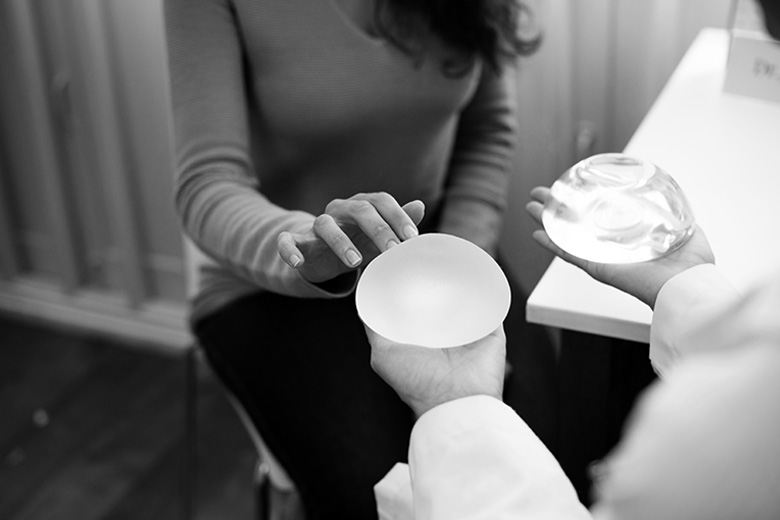March 26th, 2025
Dr. Mulholland, Md
Looking into the mirror and noticing the signs of aging are rarely met with optimism, especially when they begin to show at an age we deem too young.
For many, losing their tight and smooth jawline to sagging skin is not only the first sign of aging to hit them; it’s also the most noticeable. This area of loose skin is what is known as a jowl.
If you’re wondering how to prevent jowls, how sagging jowls form, to begin with, or what you can do to treat jowls after they appear, our reputable Toronto plastic surgery clinic has the answers. But let’s start with the most basic question; what are jowls?
What Are Jowls?
The official jowls definition refers to when we talk about sagging and excess skin around the neck. More specifically, the skin around the cheek and mouth areas droop to around the chin and jawline.
This typically occurs due to the natural aging process. As we get older, your body begins to slow down its production of collagen and elastin, which are required for the skin’s ability to stretch and bounce back, as well as stay soft and supple.
As the connective tissues and facial muscles that keep your skin nice and tight to your face begin to weaken pairs with less skin elasticity, the combination causes the appearance to droop down, creating saggy skin.
The worst part is, when we say this is part of the aging process, it doesn’t begin when you’re already old – not even close! Collagen production slows down as early as our 20s, and jowls are often one of the first things that can start to show signs of aging. Many patients of ours have reported noticing visible sagging jowls as early as their early 30s.
Other Causes of Jowls
Besides the natural progression of time, many other lifestyle factors can cause or further define sagging skin and its appearance, including the following:
- Sun damage
- Overconsumption of alcohol
- Chronic smoking
- Extended dehydration
- Looking down for long periods at a time (working at a computer, for example)
- Severe or constant states of stress
- Poor diets lacking antioxidants and healthy fats
- Repetitive facial habits and facial expressions involving the cheek, mouth, and jaw areas (chewing gum, extended talking)
- Allergies and poor air quality (pollution)
- Improper skin hygiene and lack of skincare like moisturizing
- Poor exercise habits
- Family genetics
- Extreme or sudden weight loss resulting in loose skin
- Some illnesses or conditions that may cause skin quality changes
How Can You Prevent Jowls?
Often the formation of a jowl is out of a person’s control, especially if the jowls are caused by aging and genetics. However, if you’re wondering how to reduce sagging jowls, there are some things people can do to help minimize their appearances and improve skin laxity.
Suppose you find yourself guilty of many of the above-listed items, such as smoking, excess drinking, and poor dietary habits. In that case, cutting down on these poor habits while remaining properly hydrated will not only help the prevention of sagging jowls but slow down the effects of aging everywhere on your body.
Working with your face down for long periods can enhance gravity’s pull against your skin, so keeping an ergonomic setup where your head can stay levelled or slightly reclined is beneficial.
In terms of skincare, keeping your skin moisturized will help prevent it from drying out faster, and long term can slow the look of aging. Some find that treatments like chemical peels or skin tightening creams can help stimulate collagen production and prevent the look of jowls. However, these do not work for everyone.
Our Treatments for Jowls
Preventative measures can sometimes only take you so far in preventing the formation of jowls. When these methods no longer do the trick, our clinic has many options to help you to get rid of jowls and enjoy more youthful appearance.
Neck Lift
Platysmaplasty, known more commonly as a neck lift surgery, is a cosmetic procedure that works to improve the signs of aging in the jaw and neck areas, including treating jowls. A neck lift is done by making an incision along the sides of the face and under the skin. The skin is then repositioned, and fat in the jaw and cheeks are sculpted into place. In some occasions where fat may be limited, facial fat grafting will be applied here to achieve a fuller effect. Any excess or saggy skin is then removed, and muscles in the area are tightened up.
This results in a far smoother, tighter appearance, giving a streamlined jawline vs having sagging jowls. Neck lifts are often considered the most effective treatment for combatting sagging jowls and can be paired with other facial procedures.
Facelifts
Getting a facelift procedure can remove years, even a decade off a person’s face. As such, they are one of the most popular procedures we perform to treat signs of aging such as brow drooping, wrinkles, and of course, sagging jowls.
Our clinic offers several varieties of facelifts that range in complexity and areas on the face that are treated based on a patient’s individual needs for tightening loose skin.
Mini Facelift
Let’s start with the least invasive facelift surgery options for treating jowls. The mini facelift is a minimally invasive surgery that works to target the lower portion of the face. This is done by making small incisions by the ears, and areas of concern like minor lines and wrinkles, and sagging skin in the lower portion of the face, such as jowls, are treated. Quite often, we simultaneously perform fat grafting during this procedure to improve cheek fullness and keep your face looking younger for years to come.
As previously mentioned, this is a far less intensive surgery compared to other facelifts and is not recommended for those with more severe signs of aging. Instead, the ideal candidate for a mini facelift is somebody who does not display any visible signs of aging, such as deep lines and wrinkles, and only needs to address particular issues such as sagging jowls treatment, cheeks, or mouth lines.
This procedure is often favoured by younger patients in their 30s and 40s, who do not yet require the work of more intensive facelift procedures but wish to treat the presence of a jowl. Those who require further work may instead need the work of a full facelift.
Mid Facelift
This procedure is sometimes known as a cheek lift. As the name may suggest, this facelift targets the mid-section of the face.
While not touching the upper area of the face, the mid-facelift touches on areas around the eyes, nose, and cheeks. Incisions are made, the skin is smoothed out, and fat can be repositioned and added into the cheeks during this procedure for a more rejuvenated look and youthful appearance. Having higher, fuller cheeks can help prevent the skin from dropping down and contribute to sagging jowls.
Full Facelift
Our clinic offers two types of facelifts to help treat jowls, the deep plane and the SMAS facelift.
Deep Plane:
A deep plane facelift is considered to be the most extensive type of facelift procedures. During a deep plane facelift, incisions are made into the face that goes on a deeper level than other facelifts, reaching deeper muscle levels in the face. Being able to perform on deeper levels of the face allows for a stronger manipulation of the underlying tissue. These tissues and muscles are then tightened very carefully, as not to damage exposed nerves and muscles. The fat in the face is then repositioned for a fuller appearance, and the skin is smoothed out.
SMAS:
SMAS stands for “Superficial Musculo-Aponeurotic System”. This refers to a layer of connective tissue that covers areas of the face like the face and neck; this layer is one of the leading support structures for the shape of your face. By targeting and repositioning this layer of tissue, signs of aging like sagging jowls and deep smile lines can be addressed and corrected.
TPS offers both women’s and men’s facelift procedures.
Liposuction
Liposuction can be performed all over the body, from the stomach, legs, arms, and even the face.
Fat deposits forming and building up around the cheek, chin and neck area are very common. These stubborn pockets can be difficult to remove even with proper diet and exercise and require liposuction for proper removal.
Facial liposuction is a cosmetic surgery that is minimally invasive and can work to remove these stubborn fat cells within the face effectively.
Facial liposuction is commonly performed alongside other procedures such as facelifts, neck lifts, blepharoplasty, and fat grafting. The cost of liposuction ranges depending on the area and complexity of the procedure. Pricing generally starts a $6999. For men’s liposuction costs, check out this page.
Facial Fat Grafting
Also known as a fat transfer, fat transplant, or micro sculpture fat graft, fat is taken from a donor area on the body, usually where the patient has unwanted fat such as the thighs or abdomen. The fat and stem cells are then relocated to the desired area in the face. This can be used to raise cheekbones, fill out hollowed cheeks, and be an effective jowls treatment.
Fat grafting is an appealing option for many patients with several benefits. First of all, many patients appreciate that the fat is natural and comes from their own body, rather than involving a foreign injectable. Unlike other fillers, fat transfers are also long-lasting and rarely need to be “topped up” as long as the patient remains in reasonably similar heath to when they had the procedure. Larger volumes can be transferred here as well, versus other injectables, for more substantial results.
Lastly, many patients enjoy this option as it acts as a “2 in 1” procedure. The donor area receives liposuction to transfer the fat, which can help slim down and improve the overall body contour of the area.
Dermal Fillers
Injectable dermal soft tissue fillers are an alternative method to facial fat grafting that can boast similar results. There are a number of different types of dermal fillers, such as Juvederm, Revanesse, or Teosyal.
As jowls result from a lack of volume under the skin, these fillers work as a preventative treatment by filling them up, as the name implies. The fillers work to lift and hold the skin into its original (or better) condition by injecting the dermal fillers into the area where the fat deposits are depleted.
Many prefer this method to treat jowls, as it does not involve surgery to perform, as even fat grafting involves requires surgery to perform the donor liposuction. As this method is non-surgical, there is far less bruising or swelling after the procedure as well. This method is also far cheaper than other options, with prices ranging in the hundreds rather than thousands.
However, a drawback of receiving dermal fillers to treat jowls is that fillers are not a permanent solution. Unlike other procedures such as facial fat grafting, fillers only last a few months (roughly between 9-14 months) before they begin to wear off and require further applications.
There are a few advantages to using these Dermal Soft tissue fillers to prevent a jowl from forming:
- They do not require a fat donor site to be taken from to inject.
- They often provide less facial swelling and bruising after the procedure.
- An often appealing effect is that results are immediate.
However, unlike facial fat grafting, where the cells can survive for many years, the disadvantage of gel dermal fillers is they only last about 9-14 months before wearing off and require reapplication, or else the appearance of the jowl may return. However, those nervous about receiving work done may find this beneficial as a way to “try out” a cosmetic procedure to treat their jowls before committing to a more permanent solution.
In Closing
Whether you’re looking for sagging jowls treatment, reduce the look of facial wrinkles, or remove the dreaded double chin, we can help you.
Our clinic combines top-level surgeons with decades of expertise with state-of-the-art equipment to make sure your surgical or otherwise procedures are the best they can be.
So if you’re ready to say goodbye to those sagging jowls or just want to know more, please give us a call at 647-723-3739, or book a consultation through our website to get in touch with a member of our excellent team, and we’ll guide you through everything you need to know.



